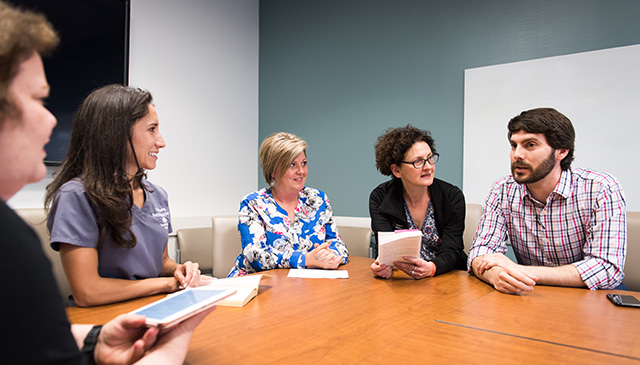
Being a clinician in today’s fast-paced health care environment can be stressful. The expectation to see more patients and produce better, quicker results stretches the limits of even the best care givers in the field. As a result, a level of compassion and empathy can be lost, which in turn can impact the quality of care given to patients and their loved ones.
Texas Children’s nurtures compassionate, empathetic, humanistic relationships between clinicians and patients. To better support care givers in creating and sustaining these types of relationships, Dr. Daniel Mahoney, a palliative care physician, and Dr. Gwen Erkonen with the Pediatric Intensive Care Unit have created a Medical Humanities Program at Texas Children’s for Texas Children’s faculty and staff.
In affect for less than a year, the program works to incorporate humanities such as literature, philosophy, ethics, sociology, visual and performing arts into medical education and practice. What this has looked like thus far, has been opportunities for care givers to participate in music therapy sessions and book clubs geared toward clinicians. The program also is working to teach and implement narrative medicine and parallel charting.
“Our hope is the tools provided through this program will help clinicians better process the myriad of experiences they deal with on a daily basis,” Mahoney said. “As a result, we hope it will enhance the way we practice medicine.”
Dr. Amanda Ruth, a PICU physician, attended one of the program’s recent book clubs and said she got a lot out of it. The book, When Breath Becomes Air by Dr. Paul Kalanithi, was about a physician diagnosed with Stage 4 lung cancer.
Ruth, who deals with terminally ill patients often, said the book was interesting because it illustrated how a physician dealt with his own mortality and what it taught him about his patients and his role in caring for them.
“If you don’t connect with a family, you can’t really create an effective treatment plan,” Ruth said. “The more you understand their situation, the better able you are to care for them.”
Ruth added that she also enjoyed meeting care givers across the organization and simply unplugging from her daily medical duties, even if it’s just for a short time.
“It’s nice to not think about medicine for five minutes, to just get away and be human,” she said.
Another tool clinicians are learning through the Medical Humanities Program, is parallel charting. Some Texas Children’s residents are using parallel charting to help them implement narrative medicine into their everyday practice. When using parallel charting, residents keep two charts for each patient. One chart is to log the patient’s medical record. The other chart is to log how the patient and their experience is affecting the resident.
“Every patient and clinician has a story,” Dr. Daniel Mahoney said. “Narrative medicine teaches clinicians to pay attention to those stories and how they intersect to help cultivate a more impactful relationship.”
Dr. Daniella Saydi, a pediatric resident, said she used parallel charting during a four-week trip to Malawi and that it allowed her to think about her experience on a deeper level.
“It’s very easy to go abroad and live in the moment without actually meditating on what is going on around you,” she said. “Parallel charting allowed me to capture moments that I had forgotten about in the hustle of the work day. I can still vividly remember certain patients and details because I was able to write them down.”
Pediatric Resident Victoria Mitre is learning about narrative medicine from Mahoney and Erkonen as a member of the Primary Care Leaders Evaluating and Addressing Disparities program. Mitre said the quarterly class has helped her create a more purposeful framework for her writing and that it has driven home her longstanding belief that effective communication is perhaps the most important part of a pediatrician’s job.
“Whether it is walking into a patient’s room or starting the process of writing an Op-Ed, Dr. Efkonen and Dr. Mahoney have taught me the importance of first identifying and understanding my audience,” she said. “In clinical situations, this has helped me tailor my counseling to meet the specific needs of my patients and their families. When the work I can accomplish in clinic is simply not enough to meet their needs, narrative medicine has given me the space and tools to reflect on my experience and advocate for change. Ultimately, it has helped me take better care of myself as a physician.”
Erkonen, who studied professional burnout in the healthcare industry, said staying in touch with your emotions and connected to your patients and colleagues helps clinicians maintain meaning in their work and thus prevents burnout.
“Clinicians view a lot of tragic things, and as a result, it’s easy to let cynicism in,” Erkonen said. “That’s why staying connected is so important. It’s key to avoiding burnout.”
Burnout, Erkonen said, is something many care givers experience at some point in their career. If it’s not remedied, burnout can lead to an increase in clinician errors among other things that impede patient care and physician growth.
A robust medical humanities program that offers training throughout all levels of a clinician’s career can help prevent burnout and promote the development of a more engaged, fulfilled and empathetic clinical workforce, Erkonen said.
“If you don’t teach empathy, it won’t be cultivated,” Erkonen said. “It’s just as valuable as anything else you learn in medical school.”
For more information about the Medical Humanities Program at Texas Children’s, click here to view their page on Connect, and click here to see their page on texaschildrens.org. You also can follow the program on Twitter @TCHMedHum.

